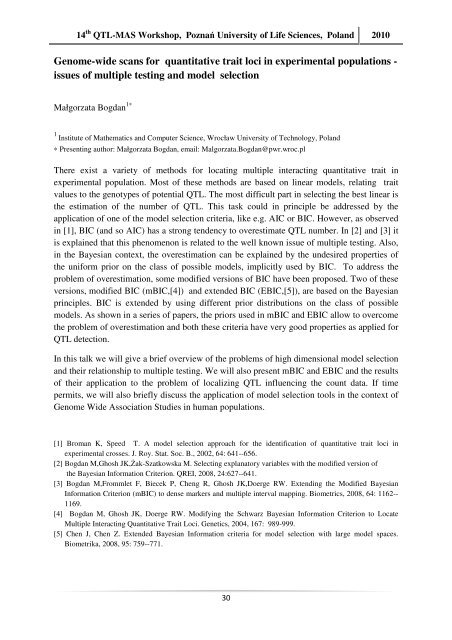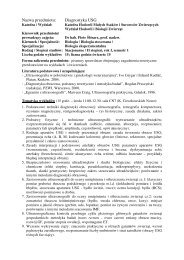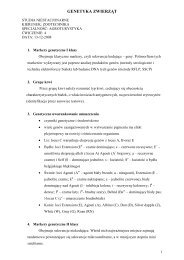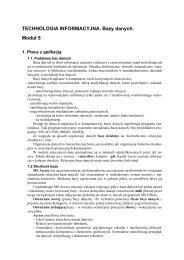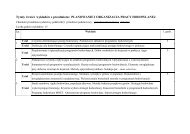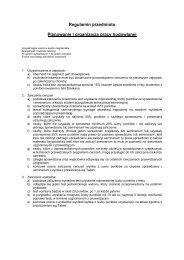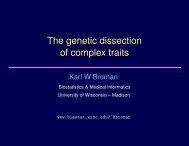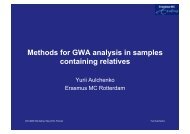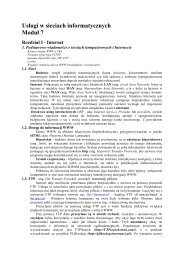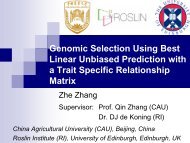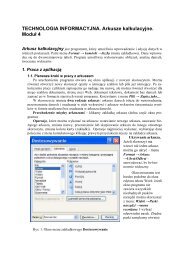The book of abstracts is available. - PoznaÅ
The book of abstracts is available. - PoznaÅ
The book of abstracts is available. - PoznaÅ
You also want an ePaper? Increase the reach of your titles
YUMPU automatically turns print PDFs into web optimized ePapers that Google loves.
14 th QTL-MAS Workshop, Poznań University <strong>of</strong> Life Sciences, Poland 2010Genome-wide scans for quantitative trait loci in experimental populations -<strong>is</strong>sues <strong>of</strong> multiple testing and model selectionMałgorzata Bogdan 1∗1 Institute <strong>of</strong> Mathematics and Computer Science, Wrocław University <strong>of</strong> Technology, Poland∗ Presenting author: Małgorzata Bogdan, email: Malgorzata.Bogdan@pwr.wroc.pl<strong>The</strong>re ex<strong>is</strong>t a variety <strong>of</strong> methods for locating multiple interacting quantitative trait inexperimental population. Most <strong>of</strong> these methods are based on linear models, relating traitvalues to the genotypes <strong>of</strong> potential QTL. <strong>The</strong> most difficult part in selecting the best linear <strong>is</strong>the estimation <strong>of</strong> the number <strong>of</strong> QTL. Th<strong>is</strong> task could in principle be addressed by theapplication <strong>of</strong> one <strong>of</strong> the model selection criteria, like e.g. AIC or BIC. However, as observedin [1], BIC (and so AIC) has a strong tendency to overestimate QTL number. In [2] and [3] it<strong>is</strong> explained that th<strong>is</strong> phenomenon <strong>is</strong> related to the well known <strong>is</strong>sue <strong>of</strong> multiple testing. Also,in the Bayesian context, the overestimation can be explained by the undesired properties <strong>of</strong>the uniform prior on the class <strong>of</strong> possible models, implicitly used by BIC. To address theproblem <strong>of</strong> overestimation, some modified versions <strong>of</strong> BIC have been proposed. Two <strong>of</strong> theseversions, modified BIC (mBIC,[4]) and extended BIC (EBIC,[5]), are based on the Bayesianprinciples. BIC <strong>is</strong> extended by using different prior d<strong>is</strong>tributions on the class <strong>of</strong> possiblemodels. As shown in a series <strong>of</strong> papers, the priors used in mBIC and EBIC allow to overcomethe problem <strong>of</strong> overestimation and both these criteria have very good properties as applied forQTL detection.In th<strong>is</strong> talk we will give a brief overview <strong>of</strong> the problems <strong>of</strong> high dimensional model selectionand their relationship to multiple testing. We will also present mBIC and EBIC and the results<strong>of</strong> their application to the problem <strong>of</strong> localizing QTL influencing the count data. If timepermits, we will also briefly d<strong>is</strong>cuss the application <strong>of</strong> model selection tools in the context <strong>of</strong>Genome Wide Association Studies in human populations.[1] Broman K, Speed T. A model selection approach for the identification <strong>of</strong> quantitative trait loci inexperimental crosses. J. Roy. Stat. Soc. B., 2002, 64: 641--656.[2] Bogdan M,Ghosh JK,Żak-Szatkowska M. Selecting explanatory variables with the modified version <strong>of</strong>the Bayesian Information Criterion. QREI, 2008, 24:627--641.[3] Bogdan M,Frommlet F, Biecek P, Cheng R, Ghosh JK,Doerge RW. Extending the Modified BayesianInformation Criterion (mBIC) to dense markers and multiple interval mapping. Biometrics, 2008, 64: 1162--1169.[4] Bogdan M, Ghosh JK, Doerge RW. Modifying the Schwarz Bayesian Information Criterion to LocateMultiple Interacting Quantitative Trait Loci. Genetics, 2004, 167: 989-999.[5] Chen J, Chen Z. Extended Bayesian Information criteria for model selection with large model spaces.Biometrika, 2008, 95: 759--771.30


